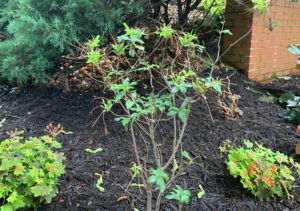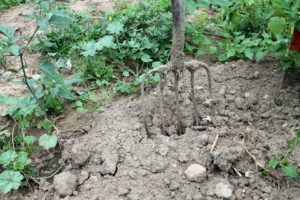Failure to Thrive
August 3rd, 2021
Plants sometimes just aren’t happy where you put them.

This azalea is being stunted by big tree roots nearby.
Good plants just sit there and seemingly sulk, barely growing or worse – starting down that road to a slow death.
Once you realize you’re dealing with a “failure-to-thrive” situation, the best thing you can do (usually) is dig up the plant and try again.
Sometimes just improving the soil and replanting in the same place is enough to make a big difference.
Other times, moving the plant to a more amenable location turns the table.
From what I’ve seen over the years, two main factors are behind most cases of stunted growth – 1.) lousy soil and 2.) wrong location.
Soil issues

Good luck if you’re trying to plant into this.
So many yards have atrocious soil for plant growth. It’s often heavy with clay or a blend of clay, shale, and subsoil that was spread in a four- to six-inch layer over packed, graded subsoil during home construction.
This compacted layer is death waiting to happen for all but the most abuse-tolerant species – barberries, ornamental grasses, yews, junipers, and the rest of the common short list that landscapers with replacement guarantees have learned to bank on.
If you don’t loosen, improve, and basically “fluff up” your garden beds before planting, most plants will never thrive. They’ll stunt, rot in poor drainage during wet weather, die during droughts because their roots haven’t penetrated the concrete-like “soil,” become more vulnerable to bugs and disease, and/or limp along in slow-death mode.
In that scenario, the sooner you dig them and do what you should have done in the first place – i.e. loosen the soil to 10 or 12 inches and work two to three inches of compost or similar organic matter into it – the better your odds of salvaging the plant.
I’ve often done this and can almost hear plants go, “Ahhhhhhh!” when they’re replanted in amended raised beds and given a good watering.
Most recently, I saved a near-death Scarlet Fire Kousa dogwood that had showed up small and “root-challenged” from a mail-order nursery. It limped along for a few months before I dug it up, greatly improved the soil, and replanted in a slightly raised mound. A year later, it’s growing nicely.
Replanting in the same spot also gives you a chance to correct other planting miscues that commonly stunt growth, such as planting too deeply (root flares should be above grade), leaving the burlap on tree and shrub rootballs (it should come off once the plants are in the holes), and mulching excessively (three to four inches is maximum around trees, shrubs, and evergreens, and one to two inches is plenty around flowers).
Wrong spot
Sometimes, though, the problem is more with location than bad soil or poor planting technique.

Tree roots are an underrated source of plant-stunting, especially when they’re less obvious than this.
Sun-loving plants that are in too much shade will never thrive and may not bloom at all.
Shade-preferring plants that are in too much sun will bleach, brown around the leaf edges, and/or possibly die from excess heat and light.
As surrounding bigger plants grow or die, the light can change, leading to new stresses for a plant that used to be “happy.”
Most underrated of all is the stunting that tree roots can cause to other plants – especially young or shallow-rooted ones.
Tree roots can extend out in the ground more than twice the distance of the leaf canopy, out-competing other plants for moisture and nutrients that are seemingly well out of range.
Some trees even exude plant chemicals that directly impede the growth of sensitive other plants. Best known is how walnut trees are good at killing off much of their would-be competition, but sumac, tree-of-Heaven, sugar maple, and even some pines have allelopathic traits as well.
In each of those scenarios, the solution is digging and moving the plant to a new location.
I’ve seen plants go from near death to thriving just by moving them a few feet, say, around the corner where they’re suddenly getting better light.
When roots are the issue, it’s usually not harmful to a healthy tree to remove up to 10 percent of its feeder roots and to replant your struggling plants into the cleared ground. However, keep in mind that the tree roots are going to grow back in – maybe even more vigorously if you’ve improved the soil.
It’s possible that a few root-free years might be enough for a struggling plant to gain a competitive foothold, but a better bet might be to move your root-unhappy plants well away from trees and to plant the root-infested area with species that can tolerate tree-root competition, such as liriope, smooth hydrangeas, hostas, and variegated Solomon’s seal.
The down side of doing nothing
Many gardeners are reluctant to move or dig and replant stunted plants because they fear the stress will be enough to finish off the struggler.
For sure, digging can be a fatal blow – especially if you’re doing it in the middle of a hot summer spell. (The cooler and usually wetter times of early spring and early fall are better options.)
But doing something helpful in the long run at least gives a stunted plant a fighting new chance and is better than doing nothing and watching the plant continue to go downhill.
Plants seldom overcome lousy-soil and location issues to go on to suddenly thrive on their own.
What most people try to do instead is fertilize.
While lack of soil nutrition can certainly stunt plant growth, that’s usually not the issue – at least not nearly as often as lousy soil and wrong location.
Even lack of water is a more common cause of stunting than lack of proper soil nutrition.
That one is among the easiest to diagnose… if it hasn’t rained in awhile and you haven’t given stunted plants a good soaking lately, then stick your finger in the ground. If the soil is dry, water. If it’s damp, then something else is at play.
The bottom line is to not overlook the shovel as a solution to a stunted plant.
It’s one of the best weapons you have in your plant-fixing arsenal.







